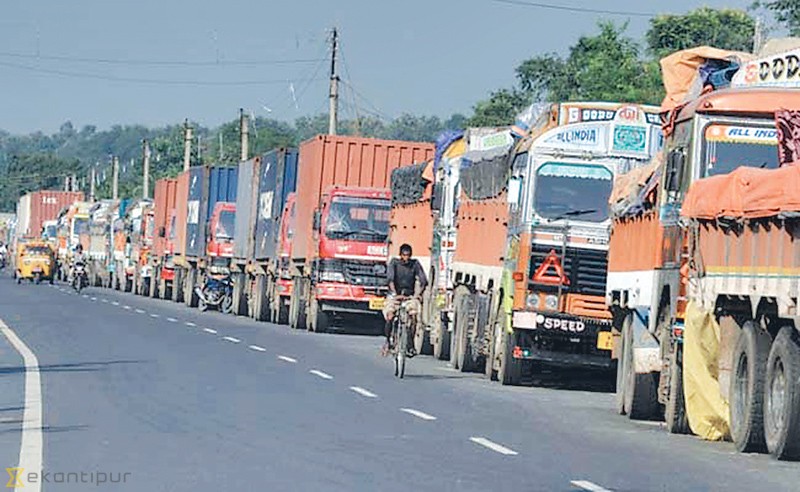A year after statute adoption
Kathmandu, September 19, 2016:Â The most surprising, or rather, the most humiliating, upshot of the promulgation of the constitution exactly a year ago was the Indian blockade, which chocked supplies of almost everything to the country.
The trade embargo, which prolonged for four-and-a-half months, created an acute shortage of petroleum products, medicines, construction materials and almost everything that came from India. It also pushed prices of consumer goods through the roof, and caused pain to the ordinary people, who had to wait in serpentine queues to get rationed petrol, diesel and cooking gas, or commute in crowded public vehicles.
Ultimately, the impact of the blockade was badly felt by the economy, as Nepal’s gross domestic product growth rate shrunk to 0.8 percent in the last fiscal year. This growth rate was the lowest in the last 14 years and came as the economy was trying to rise from the rubble of devastating earthquakes of the previous fiscal year.
This, many analysts say, was the price Nepal had to pay for coming up with a charter that had the backing of almost 90 percent of the members of the Constituent Assembly, who were elected by the people. While India’s response enraged many and fuelled anti-India sentiments, the blockade also exposed gaping holes in the energy sector of energy-deficit Nepal, country’s overdependence on India for supplies of almost everything from food, fertiliser to fuel, and a laidback nature which led to formulation of short-term plans and strategies.
These weaknesses were appalling, but they served as a wakeup call for the government to act. And the government did respond.
Soon, a 10-year plan to make Nepal self-sufficient in clean energy was introduced, incorporating proposals to generate an additional 1,450 MW of electricity within the next three years, and diversify the mode of hydroelectricity generation from run-of-the-river to reservoir, pump storage and peaking run-of-the-river.
Also, plans were laid to endorse a master plan on transmission lines — including cross-border transmission lines — within three months, provide electricity to all Nepalis within 10 years, and sign dollar-denominated Power Purchase Agreement for a period of up to 10 years with project developers who have brought investment from abroad.
Around that time, Nepal Oil Corporation (NOC), the state-owned petroleum monopoly, was told to raise the storage capacity of petroleum products to meet the market demand of at least three months even in the case of halt in imports, from existing three weeks.
Later, Nepal also signed Transit Transport Agreement for the first time with China, which was hailed as “landmark†and was supposed to pave the way for the landlocked country to use the nearest sea port in China for third-country trade, providing an alternative to the Indian port in Haldia.
These were tall promises. But as days passed by, and memories of the blockade started fading away from the minds of people, the government, too, has started reneging on its promise.
After all, false promise has long been a staple of successive Nepali governments. And this provides a vivid illustration of indifferent attitude of the government towards public interest.
“It’s unfortunate, but the political leadership is not interested in economic issues at all,†said senior economist Posh Raj Pandey. “For instance, Nepal has not done anything after signing framework agreement on transit transport with China. Till date, we are only talking about getting access to one sea port in China and conducting third country trade through it. The government still has not made sure whether the deal also allows Nepal to conduct trade with third countries using China’s road network.â€
This is the same with plans to develop the country’s energy sector. Nepal, home to around 6,000 rivers, rivulets and tributaries, has the potential to generate over 50,000 MW of electricity. But as of last fiscal year, the country’s installed capacity stood at 847.68 MW, whereas peak demand stood at 1,385 MW, shows the Economic Survey 2015-16.
There is big gap in demand and supply of electricity because Nepal has not been able to build relatively bigger hydropower plants since 70MW Middle Marsyangdi Hydroelectric Project, located in Lamjung, came into operation in 2008. But, it appears, the government has not made serious efforts to implement the 10-year plan on energy development introduced after the Indian trade blockade, as it is yet to be transformed into law. Same is the case with the plan to expand the storage capacity of NOC.
The government plans to build new storage facilities in Pachkhaal of Kavre, Tanahu and Nuwakot. Earlier, NOC had sought the government’s support in acquiring the land for the construction of fuel storage facilities. But till date the government has not been able to decide on this issue. “Nothing is going to happen here unless the political leadership stops scoring political points and focuses on fundamentally important issues that can change people’s lives,†said Pandey.
By Rupak D Sharma







